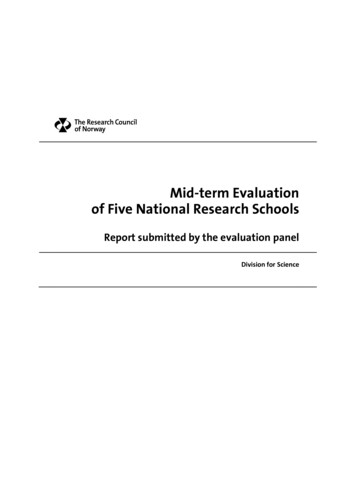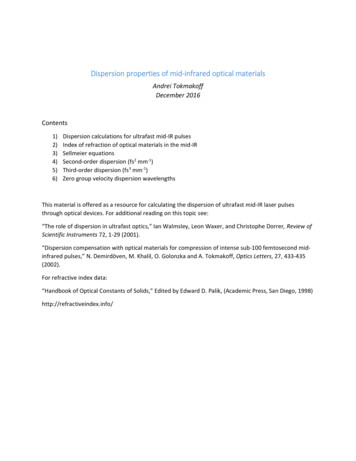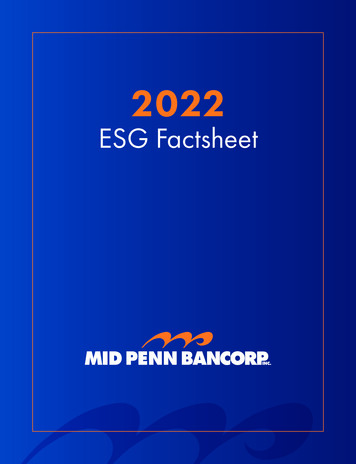
Transcription
Mid-term Evaluationof Five National Research SchoolsReport submitted by the evaluation panelDivision for Science
The Research Council of Norway 2013Report submitted by the evaluation panelThe Research Council of NorwayP.O.Box 2700 St. HanshaugenN–0131 OSLOTelephone: 47 22 03 70 00Telefax: 47 22 03 70 01bibliotek@rcn.nowww.rcn.no/englishThe report can be ordered at:www.forskningsradet.no/publikasjoneror green number telefax: 47 800 83 001Oslo, May 2013ISBN 978-82-12- 03225-5 (pdf)1
Table of contentsPreface by the Research Council of Norway. 3Abbreviations used in the report . 41. Executive summary . 52. Introduction . 73. The evaluation panel . 94. Mandate and terms of reference for the mid-term evaluation . 95. Evaluation process . 106. Evaluation of the research Schools . 116.0 Summary of the panel’s recommendations to the research schools . 116.1 National Research School in Business, Economics and Administration (NFB) . 126.2 Norwegian Research School in Climate Dynamics (ResClim) . 176.3 National Graduate School in Educational Research (NATED) . 216.4 National Research School in Medical Imaging (MedIm) . 266.5 National Graduate School in Structural Biology (BioStruct) . 307. General observations and recommendations . 34Attachments . 392
Preface by the Research Council of NorwayThe scheme for national research schools (FORSKERSKOLER) was launched in 2008. Thepurpose of the scheme is to enhance the quality and raise the academic level of PhD educationin Norway based on national networks of cooperating institutions. Five research schools werefunded after the first call and their activities were launched in 2009. A Nordic scientificprogramme committee was appointed, with responsibility for assessing grant applications,monitoring the progress of the FORSKERSKOLER scheme and serving as the evaluationpanel for carrying out the mid-term evaluation.The task of the evaluation panel has been to evaluate the quality of and progress achieved bythe five research schools and to provide a recommendation as to whether funding should becontinued to cover the full eight-year period or terminated after five years. The evaluationpanel was also asked to provide general observations and recommendations regarding theprogramme as such.This report summarises the findings of the evaluation panel.Oslo, May 2013Anders HanneborgExecutive DirectorDivision for Science3
Abbreviations used in the AUiBUiNUiOUiSUiTUMBUNISUniversity College of ÅlesundUniversity College of BuskerudUniversity College of LillehammerUniversity College of MoldeUniversity College of Oslo and AkershusUniversity College of ØstfoldUniversity College of Sør-TrøndelagUniversity College of VestfoldNorwegian School of EconomicsNorwegian University of Science and TechnologyUniversity of AgderUniversity of BergenUniversity of NordlandUniversity of OsloUniversity of StavangerUniversity of TromsøNorwegian University of Life SciencesUniversity Centre in SvalbardNIFUNOKUTRCNUHRNordic Institute for Studies in Innovation, Research and EducationNorwegian Agency for Quality Assurance in EducationResearch Council of NorwayNorwegian Association of Higher Education Institutions4
1. Executive summaryThe Research Council of Norway (RCN) established the scheme for national research schoolsin 2008. The scheme was launched as a supplement to ordinary PhD programmes, offeringspecialised courses and networks across institutions. After the first call (amounting to a totalof NOK 115 million) five schools were selected to run for an eight year period, pending asuccessful mid-term evaluation performed by a Nordic panel appointed by the ResearchCouncil.In this report the panel presents the outcome of the midterm evaluation as well as insightsgained across the schools and in relation to the second call launched in 2012 (NOK 215million distributed amongst 10 research schools).Chapters two to five give an introduction to the Norwegian PhD education and to the researchschool scheme. The evaluation process, the members of the panel, the mandate and theevaluation process are presented.Chapter six covers the evaluation of each of the five research shools, the National ResearchSchool in Business, Economics and Administration (NFB), the Norwegian Research Schoolin Climate Dynamics (ResClim), the National Graduate School in Educational Research(NATED), the National Research School in Medical Imaging (MedIm) and the NationalGraduate School in Structural Biology (BioStruct). The chapter presents recommendations foreach of the schools and in addition gives the following advice: Continuous funding is recommended for all five schools to cover the full eight yearperiod, according to the proposed budget Stronger formal links between the institutions and the research schools should beestablished. The schools should be more than just a ’course factory’. To meet thisdemand the Research Council is encouraged to prepare a “charter” to be agreed uponby the research schools and the grade giving institutions. The “charter” should ensurestronger involvement by the institutions and supervisors and also ensure rules for therelation between courses and ECTS points. The organisation of the research schools should be guided by rules set up by theResearch Council and ensure that there is a separation between the school director andthe chair of the board. Also, it should be ensured that a suitable number of PhDcandidates are selected as members of each school’s board. All courses should be evaluated by course participants and feedback usedsystematically, by criteria agreed upon by the partner institutions.Chapter 7 summarise additional insights gained through the evaluation process and includesthe following additional advice: ECTS points given for a given course should be accepted by all grade givinginstitutions.5
Measures to ensure agreements between all the faculties and institutions organisingPhD programmes within the same field of science should be taken. The cooperationbetween the medical faculties at the universities seems to be well-functioning in thisrespect and may serve as a model. Internationalisation. It is to be considered to which extent a research school fundedby the Research Council should be the institution of choice for funding grants for PhDcandidates visiting international universities and labs. Alternatively this should beconsidered the responsibility by the home institution (the employer) or offered by aspecial Research Council programme. In relation to future calls demands should be to document a formal mutual acceptanceand agreement between the partner institutions and the school (the host institution). Inaddition the application should describe plans for a continuation strategy (embedmentof activities). Cost-effectiveness of the research schools and size of the grants should beconsidered. Large grants could be limited for a few selected key areas with a specialpotential for giving a high output, for example areas where a special effort is required. A final evaluation of the scheme should be performed some years after the fundinghas ceased. The evaluation parameters should include completion rate, time-to-degreeand professional career of the research school attendees, and should be compared tosimilar information for the total Norwegian PhD candidate population. Measuresshould be taken at this point to ensure collection of the data needed.In conclusion the panel finds the research school scheme of the Research Council of Norwaysuccessful, but with room for further improvement in order to reach the goals set forward forthe scheme.6
2. IntroductionThe scheme for national research schools(FORSKERSKOLER)The FORSKERSKOLER scheme was established in 2008, based on a report commissionedby the Ministry of Education and Research in 2006. The purpose of the programme is toenhance the quality and raise the academic level of PhD education by encouraging leadingnational institutions to join forces. The national research schools are meant as a supplement toordinary PhD programmes. Thus, it continues to be the individual academic institutions, notthe research schools, that confer PhD degrees upon their own candidates. All PhD candidateswho take part in a national research school must first be admitted to an ordinary PhDprogramme at a degree-conferring institution, and consequently fulfil the requirementsestablished by that institution.The research schools are also expected to contribute to increasing degree completion andreducing the time-to-degree, as well as ensuring a broader base in researcher training. Theyshould in particular strengthen doctoral training in specialised subject areas through organisedcooperation between institutions. Typically each school will have a number of partners, one ofwhich serves as the host institution and takes a leading position. The host institution must be ahigher education institution offering PhD programmes. Most of the partners will be equallyqualified, and higher education and research institutions without PhD programmes may alsojoin in as partners. The FORSKERSKOLER scheme is financed by the Ministry of Educationand Research and administered by the Research Council of Norway (RCN).The first call for proposals was issued in 2008. A total of 27 applications was received, andfive national research schools were awarded grants. The grants for all five schools amount toNOK 115 million for the full eight-year period, 2009–2016. The research schools started uptheir activities at the beginning of 2009. The schools signed contracts with the RCN for aperiod of up to eight years. Funding for the final three years of the period was madecontingent on a positive outcome of a mid-term evaluation after approximately four years.The call is enclosed as Attachment A.The second call was issued in 2012. A total of 29 applications was received in this round. Tenresearch schools were awarded grants and will start up their activities in 2013. The grants forall 10 schools amount to NOK 218 million for the full eight-year period, 2013–2020.The Norwegian PhD systemThe Norwegian PhD education system conforms with the Bologna reforms of 2002 and is partof the European Qualification Framework. It has a three-level degree structure, withbachelor’s, master’s and PhD. The Norwegian Agency for Quality Assurance in Education(NOKUT) is responsible for accreditation and quality assurance of the higher educationinstitutions, and the Norwegian Association of Higher Education Institutions (UHR) developsrecommended guidelines for regulation of PhD degrees. The Norwegian PhD educationsystem was evaluated in 2011–2012, and much of the information in this section is based onthe evaluation report: PhD education in a knowledge society: An evaluation of PhD educationin Norway, NIFU Report 25/2012.Within these regulatory frameworks, the universities and the specialised higher educationinstitutions can stipulate more detailed regulations for PhD degrees at their own institution,although they generally follow the recommended guidelines for regulation of PhD degreesadopted by the UHR. NOKUT grants the right to award PhD degrees to the universitycolleges.7
A PhD degree is only attainable by following a structured programme, consisting of aresearch component and a taught component (courses) of at least a half year of full-timestudy. “Doctoral education normally consists of three years of full-time study, and includesrequired coursework comprising a minimum of 30 ECTS points. The way in which doctoraleducation is organised is to be stipulated in the institution’s regulations” (from the UHRguidelines).Each institution normally has one general set of regulations for its PhD degrees. There mayalso be specific regulations for each PhD programme. According to the UHRrecommendations, the degree‐conferring institution is to sign a written agreement with eachcandidate admitted to one of its PhD programmes, regulating academic supervision,coursework and other training. The institution is responsible for providing adequate coursesfor the candidates at the institution itself or facilitating participation in relevant courses atother institutions. PhD‐level courses taken at other institutions are to be approved accordingto the rules of the Act relating to universities and university colleges.1There are significant differences between the Norwegian higher education institutionsregarding the balance between the coursework component and the research component oftheir PhD programmes. There is also significant variation regarding the proportion of ECTSpoints assigned to mandatory courses and the fraction of the coursework which candidates areallowed to take outside the institution.The volume of the PhD systemIn 2011 a total of 23 higher education institutions offered 112 different PhD programmes witha further 92 specialisation tracks. This means that PhD education is offered in more than 200different academic specialisations in Norway. Most of the universities have one PhDprogramme per faculty, but each programme may have discipline-based specialisation trackswith different study plans. Most of the specialised higher education institutions and universitycolleges offer one or two PhD programmes.The total number of persons enrolled in PhD programmes in Norway is presently about 9 000.About 6 000 of those enrolled hold recruitment positions as a PhD candidate(“doktorgradsstipendiat”). Most of the research fellows are employed at higher educationinstitutions, with some 1 000 employed at independent research institutes, university hospitalsetc. About 1 400 new PhD agreements are signed each year. The total number of PhD degreesawarded nationally has increased steadily from 647 in 2000, and was 1 461 in 2012. This isthe highest number ever.1Lov om universiteter og høyskoler – LOV 2005-04-01 nr. 15.8
3. The evaluation panelThe scheme for national research schools (FORSKERSKOLER) is coordinated by a scientificprogramme committee (“styringsgruppe”) of Nordic scholars with significant experience fromresearch schools in the other Nordic countries. The committee was appointed by the ResearchCouncil for a five-year period (spring 2008–spring 2013) with the following mandate: To beresponsible for the process of assessing grant applications, to follow up the schools awardedfunding, and to conduct the mid-term evaluation. The following members of the scientificprogramme committee for the FORSKERSKOLER scheme thus constituted the evaluationpanel during the mid-term evaluation period:Universitetslektor Göran Gustafsson (chair)Professor Hanne Marlene DahlProfessor Jens Jørgen GaardhøjeProfessor Christina GustafssonProfessor Ebba NexøChalmers University of TechnologyRoskilde UniversityUniversity of CopenhagenUppsala UniversityAarhus University4. Mandate and terms of reference for the mid-term evaluationThe mandate for the mid-term evaluation was approved by the Research Board of theDivision for Science in September 2012 (DSV 58/12). The mandate provides a framework forthe evaluation process and sets out terms of reference for the evaluation of the researchschools, based on the criteria stipulated in the first call for proposals issued under theFORSKERSKOLER scheme.The purpose of the mid-term evaluation is to assess the quality and success of the fiveresearch schools in relation to their original objectives and plans and to provide arecommendation to the Research Council as to whether the funding for the individual researchschools should be maintained for the full eight-year period or terminated after five years.In its mandate, the evaluation panel is also asked to provide general observations andrecommendations regarding the programme as such, on the basis of the experience gained bythe first five schools in the first four years.The complete mandate for the evaluation is enclosed as Attachment B.9
5. Evaluation processThe mid-term evaluation has been based on the following documents and backgroundmaterial on each of the research schools: A self-evaluation in a standardised form, submitted by the project manager and thechair of the board of each school. Self-evaluations were required to include an analysisof the research school: courses and activities, PhD education, recruitment,organisational aspects, national and international collaboration, and any added value.The self-evaluation was also to include a SWOT analysis.A fact sheet in a standardised form providing information on management, schoolactivities, PhD candidates, supervisors, international cooperation and financialmatters.An assessment (self-evaluation) by each of the partners, summing up the experiencegained from being part of the national research school.An assessment by the host institution, summing up the experience of hosting thenational research school.Dialogues with representatives of the five research schools conducted by the panel atGardermoen (Oslo) on 31 January and 1 February 2013. The dialogues consisted of:o Presentations delivered by each of the project managers (school directors)focusing on objectives achieved and lessons learned, and comments to theSWOT analysis;o Meetings with the project manager (school director), chair of the board andselected board members for each school (in all five to six representatives perschool);o Separate meetings with one to three PhD candidates from each research school.The panel has based its evaluation and recommendations for each of the schools on thisbackground material together with the original grant applications submitted to the RCN.The overall observations and recommendations in the report also benefit from the panel’shaving followed the schools from the beginning, and in general from the panel members’experience from research schools in Denmark and Sweden.10
6. Evaluation of the research schools6.0 Summary of the panel’s recommendations to the research schoolsThe panel recommends that funding for all five schools in the evaluation is continued for theremaining project period, as defined in the contract between the Research Council of Norwayand the research schools. Each of the evaluated schools is given specific advice for continuedoperations in the respective sections of this chapter. The evaluation of the five researchschools has led to the emergence of some general themes for the programme as such. Theseare covered in Chapter 7.It is not relevant to strive to achieve a general model for all research schools, as there arefundamental differences in the disciplinary structures and substance of the schools. It is,however, possible to extract some general observations and findings that are relevant toimproving the functioning of all five research schools. The panel’s general recommendationsto the schools are as follows: Stronger formal links between the institutions and the research schools should beestablished. The schools should be more than just a “course factory” and thesupervisors must be actively involved in school activities. The Research Council is encouraged to prepare a “charter” to be agreed upon by theresearch schools and the partners (degree-conferring institutions). The charter shouldcommit the three parties – the PhD candidate, the host institution and the school – toensure stronger involvement on the part of the supervisors. The ECTS points assigned to courses should follow rules that are accepted by alldegree-conferring institutions in the network. All courses should be evaluated by course participants on the basis of criteria agreedupon by the partner institutions and this feedback should be used systematically toensure the high quality of the courses. PhD candidate representation on the boards should be mandatory and based on aformalised election process among the school’s PhD candidates. The PhD candidatesshould be represented by two board members, or one ordinary board member and onedeputy.11
6.1 National Research School in Business Economics and Administration (NFB)Facts about NFB Operating period: 01.01.2009–31.12.2016. Grant (funding pledge) for the entire period: NOK 24 million. NHH is the host institution. The school network consists of 15 cooperatinginstitutions: HiAls, HiBu, HiL, HiOA, HiMolde, HiOf, HiST, HiVe, UiA, UiN, UiS,UiT, NTNU, and UMB. Open model – voluntary participation – the candidates register online.Supervision and follow-up of the candidates at their home institutions. 147 PhD candidates have been registered at the school from the start and 11 of themhave completed their degrees. 43 % of the PhD candidates are women. 15 PhD courses, a doctoral colloquium and a research school conference were offeredin 2012. Courses offered by NFB are normally approved beforehand by the partner institutionsin terms of ECTS points. All partner institutions are represented on the board. There are no PhD candidates onthe board. The director of the school is also the chair of the board. The board meetsonce a year. The steering committee consists of some of the board members and has severalmeetings per year. There are six scientific committees, one for each specialisation atthe school, which make decisions regarding which PhD courses to offer.Objectives of NFB (from the contract)The overall objective of the national research school is to enhance the quality of theeducation of researchers within business economics and administration in Norway.This objective has been restated in the following three operational objectives: Increase programme effectiveness, measured as the fraction of candidates thatcompletes the education within the expected timeframe with a dissertation of a highinternational standard; Increase programme attractiveness, measured as the increase in the number ofwell-qualified candidates that apply for admission; Increase “product” attractiveness, measured as the candidates’ success in pursuingfurther relevant careers.Research school structure and recruitmentIn its grant application, NFB stated that the partner institutions would have around 140candidates that would participate in the network together with their supervisors. At present12
147 PhD candidates have registered at NFB. The PhD student body is multidisciplinary andrelatively international.The research school’s PhD candidates are formally registered at their home institutions, whichmonitor their supervision and progress. For most of the participants, the NFB courses andconferences are a supplement to the PhD courses offered by their home institutions (somesmall-scale institutions do not offer PhD courses).The candidates have to apply for accreditation of the NFB courses at their home institutions.NFB claims to have had a standardising function and that ECTS points are transferred to thehome institutions without problem.Research school activitiesThe number of PhD courses offered has increased each year. In 2012, 15 PhD courses wereoffered, spanning generic, methodological and theoretical issues. There were both large (up to78 participants) and smaller courses held at different partner institutions, with credits rangingfrom 2 to 10 ECTS points. NFB also has an annual research school conference and a yearlymeeting for all the PhD candidates, called a doctoral colloquium.The research school offers a wide variety of courses within the subfields. According to thepartner institutions, the course catalogue is good and supplements the PhD courses that theyoffer. Some of the partner institutions only have a small number of candidates within the fieldcovered by the school, and therefore do not have the necessary resources to offer satisfactoryPhD courses.NFB has developed an evaluation scheme for use in all courses. If used systematically, this isa helpful tool for developing the theme and structure of the courses and the teaching of thelecturer(s) in question. For the most part, candidates express high satisfaction with the PhDcourses, even though some of the results appear to be based on very low reply rates. Someconcerns were raised in the written material and during the meetings concerning thepedagogical quality of the lecturers.The various courses and activities enable the PhD candidates to become acquainted withrenowned scholars. This increases mobility within the scientific community, which togetherwith the use of internationally recognised lecturers, is likely to improve the quality of the PhDeducation. The original plan to offer courses for supervisors at the school has beenimplemented as a supervisor workshop and seminar. The panel considers this a very goodmeasure for enhancing the quality of the learning processes.Management of the research schoolNFB is a well-functioning research school, with a board, a steering committee, a group forday-to-day management (school director, scientific coordinator and administrative projectcoordinator) and six scientific committees. With regard to the management structure, onecould question why there is no division between the director and the board, as the directoralso serves as the chair of the board.Planning of PhD courses, selection of lecturers and financial responsibility for the courses aredelegated to the six scientific committees. There are no representatives of the PhD candidateson the school board, and there seems to be little systematic contact with the candidates incourse planning.13
The leadership is evaluated as excellent by the partner institutions; there is good informationflow and governance, regular meetings and courses are announced well ahead of time,knitting the participating institutions into a well-functioning network. In this way NFB seemsto balance the interests and strengths of the various partners and include them all in fruitfulcooperation. In addition, the use of internal resources appears to work well, with professorsfrom the various institutions involved in the courses offered.National network and international collaborationThe network consists of one large, PhD degree-conferring host institution (NHH) and anumber of small partner institutions, some without PhD programmes. Collaboration andsynergy between the partners appears to be good.International collaboration is strengthened via the courses and by encouraging new contactsbetween the lecturers and individual PhD candidates and increasing the number of PhDcandidates conducting a research stay abroad. The list of international professors that havegiven lectures at the school is impressive. The scholars are mainly from the US, but therehave been researchers from Canada, Europe and the other Nordic countries as well. It has,however, proven difficult to attract visiting professors. Recruitment difficulties of this typeare a well-known problem and are due to the fact that professors are busy and often live intwo-career families.NFB also had plans to contribute financially to the engagement of international part-timeprofessors (professor II) at some of the partner institutions, with teaching obligations at NFB,but this has been limited to a few cases.Strategic importanceNFB is strategically important for bringing together rather small research communities,thereby ensuring a critical mass of PhD candidates and making more efficient use of resourcesby avoiding overlapping and/or competing courses. The school promotes internationalnetworking between the Norwegian research community and scholars overseas, which is alsoof strategic importance, and appears to have improved the recruitment of international PhDcandidates.Gender aspectsForty-three per cent of the PhD candidates are women, 22 % of the supervisors are womenand 20 % (four out of 20) of the lecturers are women. The research school has a gendermainstreaming body (“Gender Panel”), but the initiatives taken by this panel are not discussedin NFB’s internal evaluation. It is worth noting, however, that the new Journal of the NationalResearch School in Business Economics and Administration has made women visible as rolemodels as important professors in the field or as promising associate professors who alreadyhold an internationally recognised position.Financial aspectsNFB’s finances are fine. The school could not use up its allocated resources in its initial years,but now that it is fully up and running, it uses all allocated funding, including the fees paid bythe partner institutions. Although this is a small sum, the panel believes it plays a strongsymbolic role in keeping up commitment to a well-run school after an enthusiastic start. Theschool has decided to cover travel expenses for PhD candidates in connection with thedoctoral colloquium and research school conference, which means that the school uses14
approximately 25 % of its total funding for the reimbursement of travel expenses withinNorway.Future perspectivesNFB is seeking to simplify its governance structure by eliminating the steering committee andhaving more freque
HiL University College of Lillehammer HiMolde University College of Molde HiOA University College of Oslo and Akershus HiOf University College of Østfold HiST University College of Sør-Trøndelag HiVe University College of Vestfold NHH Norwegian School of Economics NTNU Norwegian University of Science and Technology .











